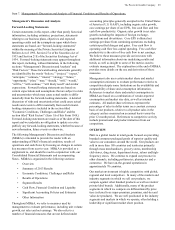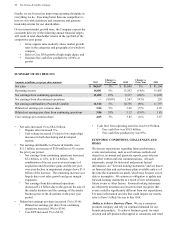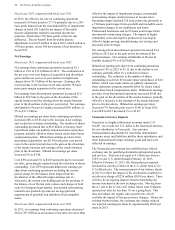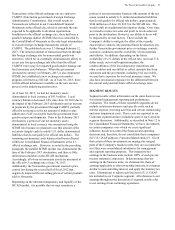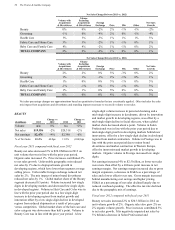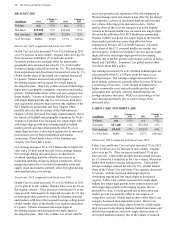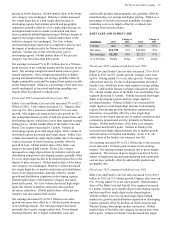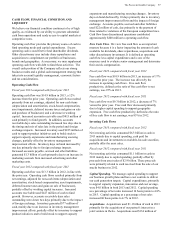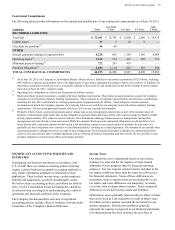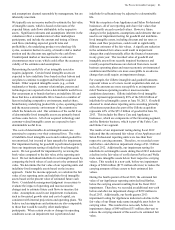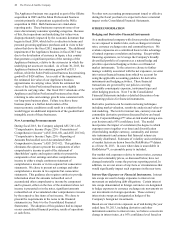Proctor and Gamble 2013 Annual Report Download - page 35
Download and view the complete annual report
Please find page 35 of the 2013 Proctor and Gamble annual report below. You can navigate through the pages in the report by either clicking on the pages listed below, or by using the keyword search tool below to find specific information within the annual report.
The Procter & Gamble Company 33
disproportionate growth in developing regions, which have
lower than segment average selling prices. Global market
share of the Beauty segment decreased 0.3 points. Volume
increased mid-single digits in developing regions while
developed region volume decreased low single digits.
Volume in Hair Care and Color grew mid-single digits
behind high single-digit growth in developing regions led by
Pantene initiatives and Head & Shoulders geographic
expansion. Volume in developed regions was down low
single digits due to competitive activity. Global market
share of the hair care category was unchanged. Volume in
Beauty Care decreased mid-single digits due to the Zest and
Infasil divestitures and the impact of competitive activity in
North America and Western Europe which contributed to
about half a point of global share loss. Volume in Salon
Professional was down high single digits mainly due to
market contraction in Europe and the impact of competitive
activity. Volume in Prestige Products increased mid-single
digits driven by initiative activity, partially offset by minor
brand divestitures.
Net earnings decreased 6% to $2.4 billion as higher net sales
were more than offset by a 100-basis point decrease in net
earnings margin. Net earnings margin decreased due to
gross margin contraction partially offset by lower SG&A as
a percentage of net sales. Gross margin decreased primarily
due to an increase in commodity costs and unfavorable
geographic and product mix, partially offset by
manufacturing cost savings and higher pricing. SG&A as a
percentage of net sales decreased due to scale leverage from
increased sales.
GROOMING
($ millions) 2013
Change vs
2012 2012
Change vs
2011
Volume n/a -1% n/a +1%
Net sales $8,038 -4% $8,339 +1%
Net earnings $1,837 +2% $1,807 +2%
% of Net Sales 22.9% 120 bps 21.7% 10 bps
Fiscal year 2013 compared with fiscal year 2012
Grooming net sales decreased 4% to $8.0 billion in 2013 on
a 1% decrease in unit volume. Organic sales were up 2% on
organic volume that was in line with the prior year period.
Price increases contributed 2% to net sales growth.
Unfavorable foreign exchange reduced net sales by 4%. The
impact of the Braun household appliances business
divestiture reduced net sales by 1%. Global market share of
the Grooming segment increased 0.4 points. Volume
increased low single digits in developing regions and
decreased mid-single digits in developed regions. Shave
Care volume increased low single digits due to low single-
digit growth in developing regions, primarily behind market
growth and innovation expansion, partially offset by a low
single-digit decrease in developed regions primarily due to
market contraction in Western Europe. Global market share
of the blades and razors category was up less than half a
point. Volume in Appliances decreased double digits due to
the sale of the Braun household appliances business,
competitive activity and market contraction. Organic
volume in Appliances declined high single digits. Global
market share of the appliances category decreased nearly
half a point.
Net earnings increased 2% to $1.8 billion due to a 120-basis
point increase in net earnings margin, partially offset by the
decrease in net sales. Net earnings margin increased
primarily due to gross margin expansion. Gross margin
increased due to pricing and manufacturing cost savings.
SG&A as a percentage of net sales decreased nominally as
increased marketing spending was offset by reduced
overhead costs.
Fiscal year 2012 compared with fiscal year 2011
Grooming net sales increased 1% to $8.3 billion in 2012 on
a 1% increase in unit volume. Organic sales were up 2%.
Price increases contributed 2% to net sales growth.
Unfavorable geographic and product mix decreased net sales
by 1% mainly due to disproportionate growth in developing
markets, which have lower than segment average selling
prices. Unfavorable foreign exchange decreased net sales
growth by 1%. Global market share of the Grooming
segment decreased 0.2 points. Volume grew mid-single
digits in developing regions due to initiative activity and
market growth and decreased low single digits in developed
regions primarily due to competitive activity. Volume in
Shave Care was up low single digits due to mid-single-digit
growth in developing regions behind initiatives, Fusion
ProGlide geographic expansion and market growth, partially
offset by a low single-digit decrease in developed regions
due to market contraction and the impact of competitive
activity. Global market share of the blades and razors
category was unchanged. Volume in Appliances decreased
mid-single digits due to market contraction in Western
Europe and the impact of competitive activity. Global
market share of the dry shave category was down over 2
points.
Net earnings increased 2% to $1.8 billion due to higher net
sales and a 10-basis point increase in net earnings margin.
The net earnings margin increase was driven by a decrease
in SG&A as a percentage of net sales, largely offset by gross
margin contraction. SG&A as a percentage of net sales
decreased due to reductions in both overhead and marketing
spending. Gross margin decreased primarily due to an
increase in commodity costs and unfavorable geographic and
product mix, partially offset by price increases.


